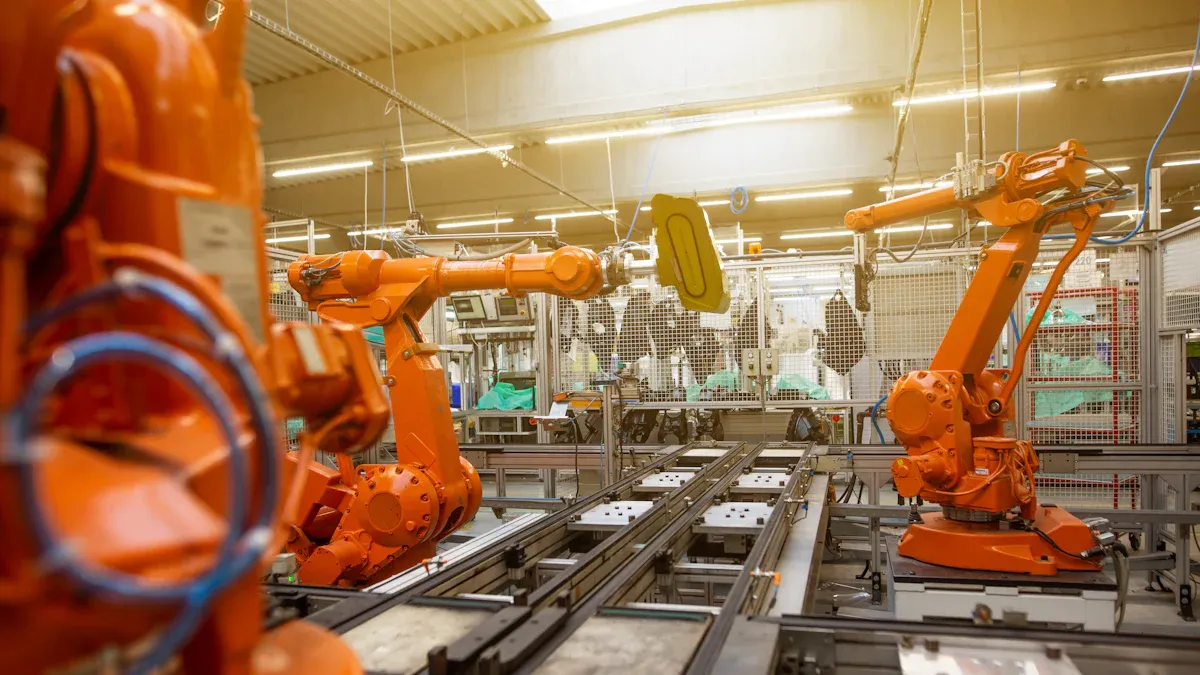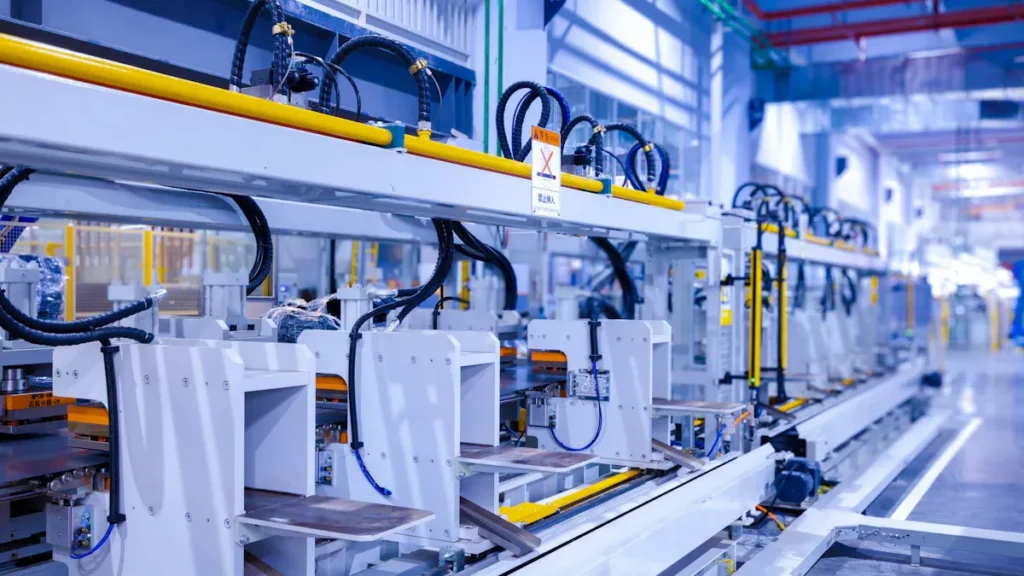
Product manufacturing turns raw materials into items you use daily. This includes your phone, furniture, or even the food you eat. Manufacturing supports industries and helps the economy grow. Did you know every $1 spent on manufacturing adds $2.47 to the economy? In 2018, U.S. manufacturers made $2,334 billion worth of goods. Over 248,000 companies helped make this happen. These facts show how important manufacturing is to our world.
Making products efficiently isn’t just about working faster. It’s about using less, saving money, and making better products. For example, creating more good products with less waste increases profits. It also helps the environment. By improving processes and fixing problems quickly, companies can work better. This helps them compete in a fast-changing world.
If you want to make production better or greener, this article can help. Let’s explore the steps, tools, and ideas that can improve your manufacturing process.
Key Takeaways
Learn about the three main steps in manufacturing: primary, secondary, and tertiary processes. These steps help turn raw materials into finished goods.
Pick the best manufacturing method for your product. Choices include discrete, process, repetitive, and job shop manufacturing. Each works for different needs.
Use machines and robots to make production faster and better. These tools lower mistakes, make more products, and save money on workers.
Follow lean manufacturing ideas to reduce waste and improve quality. Start by finding where the most waste happens and fix those first.
Use Key Performance Indicators (KPIs) to check and improve production. Track things like Overall Equipment Effectiveness (OEE) and yield rate often to find ways to get better.
Key Processes in Product Manufacturing

Knowing the main steps in product manufacturing helps make better goods. These steps show how raw materials turn into finished items. Let’s look at three main stages and the types of processes businesses use today.
Primary, Secondary, and Tertiary Processes
Manufacturing has three key stages. Each stage is important for making products:
Primary Processes:
These steps prepare raw materials for use. For example, mining ores, cutting trees, or harvesting crops. Turning iron ore into steel is a primary process that starts production.Secondary Processes:
In this stage, raw materials become finished or partly finished goods. Activities like molding, forging, or machining happen here. For instance, shaping steel into car parts or making wooden furniture are secondary processes.Tertiary Processes:
These steps include services that help make and deliver products. Examples are packaging, shipping, or creating software for machines. Studies show software jobs in this stage boost industries like logistics and construction.
Tip: Knowing these stages helps you improve production and save money.
Types of Manufacturing Processes
Different products need different methods. Here are four main types of manufacturing processes and how they work.
Discrete Manufacturing
This method makes separate items, often built from parts. Think of cars, phones, or furniture. Each product is unique and can be customized. Discrete manufacturing works well for industries needing variety and precision.
Process Manufacturing
This method creates goods in large amounts using recipes or formulas. Examples include food, drinks, and chemicals. These products can’t be separated back into their original parts. Process manufacturing is great for industries needing consistency and bulk production.
Repetitive Manufacturing
This process makes the same product over and over on a line. It focuses on speed and large numbers. For example, producing thousands of water bottles or light bulbs fits here. This method ensures products are made quickly and look the same.
Job Shop Manufacturing
This method is flexible and handles custom orders. Products are made in small amounts with special tools or skills. For example, making custom jewelry or new gadget prototypes uses job shop manufacturing. It’s perfect for businesses that value creativity and personalization.
Process Type | Best For | Examples |
|---|---|---|
Discrete Manufacturing | Unique, customizable products | Cars, smartphones, furniture |
Process Manufacturing | Bulk production with consistency | Chemicals, food, beverages |
Repetitive Manufacturing | High-volume, identical products | Water bottles, light bulbs |
Job Shop Manufacturing | Custom, small-batch production | Jewelry, prototypes |
Note: Picking the right process depends on your product and goals.
Why These Processes Matter
Good manufacturing processes affect how products turn out. For example, using Quality by Design (QbD) in medicine-making cut development time by 30%. This method focused on key steps to make better products faster. Also, using tools like automated inspections keeps quality high and reduces waste.
By learning about these processes, you can make smarter choices. This helps you save money, work faster, and give customers better products.
Technologies to Improve Manufacturing Efficiency
Manufacturing is changing fast with new technologies. These tools make work easier, cut costs, and improve production. Let’s see how automation, CAD, and IoT can help.
Automation and Robotics in Manufacturing
Automation and robots are transforming factories. They handle boring tasks so workers can focus on creative ideas. Robots don’t get tired, making products faster and with steady quality.
Here’s how automation helps factories:
Robots work all day and night, making more products.
Machines are precise, reducing mistakes and wasted materials.
Predicting repairs early avoids long stops and saves money.
Energy-saving robots lower electricity bills.
Check out the benefits below:
Benefit | Description |
|---|---|
Robots run nonstop, making more items quickly. | |
Consistent Performance | Machines keep quality steady every time. |
Reduced Downtime | Fewer stops mean less time fixing machines. |
Faster Throughput | Speeds up making, packing, and shipping products. |
Labor Cost Savings | Cuts down on hiring workers for repetitive jobs. |
Reduced Waste | Accurate machines use fewer materials. |
Energy Efficiency | Robots use energy smarter than humans. |
Improved Quality Control | Fewer mistakes mean better products. |
For example, MARC® saved $22,127 yearly with automation. They got their money back in just eight months. Worker productivity went up by 9%, and overall output rose by 22%. Automation also saved 36 hours of lost time each month.
Role of CAD in Enhancing Production Efficiency
Computer-Aided Design (CAD) changes how products are made. It lets you see designs before building, avoiding errors. CAD creates detailed plans, ensuring every step is accurate.
Here’s why CAD is important:
Test designs on a computer to avoid costly mistakes.
Make prototypes faster, getting products ready sooner.
Keep designs consistent for easy large-scale production.
Customize products to meet special customer requests.
Imagine designing a tricky machine part. CAD lets you test how it works in different situations. This ensures it’s perfect before making it. Using CAD saves time, reduces waste, and improves efficiency.
IoT for Real-Time Monitoring and Predictive Maintenance
The Internet of Things (IoT) connects machines and sensors to share data. It gives live updates on how things are running. IoT helps spot problems early and improve processes.
Here’s how IoT helps factories:
Sensors check machines and conditions in real time.
Data shows problems, letting systems fix them automatically.
Predicting repairs early avoids costly breakdowns.
Here’s a closer look:
Benefit Area | Description |
|---|---|
Predictive Maintenance | Sensors predict problems, allowing quick fixes and less downtime. |
Quality Control | Live updates find issues, improving product quality with automatic fixes. |
Supply Chain Management | Tracks inventory and shipping, making supply chains faster and better. |
IoT makes factories smarter and more efficient. For example, sensors can warn you about a machine wearing out before it breaks. This saves time and money, keeping production smooth.
By using automation, CAD, and IoT, factories can work faster, save money, and stay ahead in the industry.
Additive Manufacturing (3D Printing) for Customization
Think about making a product exactly how you want it. That’s what additive manufacturing, or 3D printing, can do. It’s like a tool that brings your ideas to life. You can design and make items without needing costly molds or tools.
Here’s why 3D printing is changing manufacturing:
Customization at Scale: Products can be made to fit specific needs. From custom phone cases to medical implants, 3D printing ensures accuracy.
Faster Prototyping: Want to test an idea? 3D printing makes prototypes quickly, helping improve designs before mass production.
Reduced Waste: Traditional methods waste materials. 3D printing uses only what’s needed, making it better for the environment.
For example, furniture makers can create unique pieces that fit perfectly in a room. In healthcare, custom prosthetics made with 3D printing change lives for the better.
Tip: Want to stand out? Use 3D printing to bring creative and efficient ideas to life.
AI and Machine Learning in Process Optimization
Ever wonder how factories stay so organized? AI and machine learning are the tools behind the scenes. They study data, find problems early, and suggest ways to improve.
Here’s how AI and machine learning help factories:
Predictive Maintenance: Machines don’t break down suddenly. AI finds issues early, saving time and money.
Quality Control: AI checks for defects, ensuring products are always high quality.
Process Efficiency: Machine learning speeds up production while keeping quality high.
Research from McKinsey shows the benefits:
Machine downtime drops by 30% to 50%.
Costs related to quality issues go down by 10% to 20%.
Picture a factory making thousands of items every day. AI watches every step, catching mistakes before they cause problems. It also improves workflows, making production faster and smoother.
Note: Using AI not only saves money but also helps deliver top-quality products every time.
By using 3D printing and AI together, manufacturing becomes smarter and more efficient. These tools help create better products faster, with less waste.
Best Practices for Efficient Production

Making production better starts with using smart methods. These steps help cut waste, save money, and make great products. Let’s look at three ways to improve how things are made.
Lean Manufacturing Principles
Lean manufacturing means cutting waste and working smarter. It helps you do more with fewer resources. By simplifying steps, you save time, money, and improve quality.
Here’s how lean helps:
Waste treatment costs drop: 4.32*.
Fewer rejects and reworks save money: 4.24*.
Check out the results of lean practices:
Metric | Before Lean | After Lean |
|---|---|---|
Production cycle time | 20 days | |
Production output | 100 units/day | 130 units/day |
Material waste | 10% | 5% |
Inventory cost | $50,000/month | $35,000/month |
FedEx used lean ideas during the 2008 recession. They increased plane checks from 14 to 30 yearly. Man-hours dropped from 32,715 to 21,535. This shows lean can improve processes and help businesses grow.
Tip: Start small. Find where waste is highest and fix it first.
Process Optimization Techniques
Process optimization makes every step work better. It reduces delays, improves accuracy, and helps meet customer needs faster.
Here’s how to optimize processes:
Use lean tools like 5S and Kaizen to improve flow.
Shorten setup times with methods like SMED.
Automate tasks to avoid mistakes and speed up work.
Faster production means happier customers and lower costs. Collecting data from all areas helps teams find and fix problems. Standardizing tasks makes production smoother and more reliable.
Note: Keep improving. Optimization is an ongoing process, not a one-time task.
Workforce Training for Better Efficiency
Workers are key to making production efficient. Training gives them skills to work faster and smarter. It also reduces errors and waste.
Here’s why training is important:
Benefit | Description |
|---|---|
Quality training programs | Projects finish on time and within budget. |
Skilled workers | Fewer mistakes and less wasted materials. |
Training during work | Saves time and boosts productivity. |
When workers know the process well, they spot problems and suggest fixes. Training also keeps them motivated, leading to better work and higher efficiency.
Tip: Offer regular training to keep your team sharp and engaged.
By following these practices, you can make production faster, reduce waste, and deliver top-quality products every time.
Proactive Maintenance to Minimize Downtime
Downtime stops production and wastes money. Proactive maintenance prevents this by fixing issues early. Instead of waiting for machines to break, you keep them working well.
Here’s why it’s important:
Cuts downtime by up to 80%.
Lowers maintenance costs by 28%.
Machines last 30-40% longer.
Check out the benefits:
Benefit | Evidence |
|---|---|
Better OEE | Improves 15-30% in two years. |
Less Downtime | 50-80% fewer breakdowns with proactive care. |
Lower Maintenance Costs | Saves 28% on repairs. |
Higher Quality | 55% fewer product defects. |
More Capacity | Boosts production by 22%. |
Safer Workplaces | 65% fewer accidents. |
Longer Equipment Life | Extends use by 30-40%. |
It also makes work safer and products better. Factories using this method see 87.3% fewer defects. Inventory losses drop by 22.5%. These gains make it essential for manufacturing success.
Tip: Inspect machines often and use sensors to track them. This finds problems early and avoids big repairs.
Using proactive maintenance saves time, boosts efficiency, and cuts costs. It’s a smart way to keep production running smoothly.
Supply Chain Collaboration for Seamless Production
A good supply chain keeps production moving. Working with suppliers and distributors ensures everything flows without delays.
Here’s how teamwork helps:
Orders arrive when needed.
Inventory moves quickly, saving storage costs.
Fewer mistakes in shipments.
Key metrics show its value:
Metric | What It Measures |
|---|---|
Percent of orders delivered as planned. | |
Inventory Turnover | How often stock is sold and replaced. |
Order Accuracy | Correctness of fulfilled orders. |
To improve your supply chain:
Set shared goals with partners.
Check and update performance measures often.
Build strong relationships with suppliers.
When everyone works together, production is faster and smoother. Companies focusing on collaboration see fewer delays and happier customers.
Note: Stay in touch. Let partners know about changes in demand or schedules.
Better supply chain teamwork reduces waste, lowers costs, and keeps production steady. It’s a smart move to stay ahead in today’s market.
Measuring and Improving Production Efficiency

Making production better helps businesses stay ahead in today’s world. By tracking the right numbers, you can find problems, cut waste, and work faster. Let’s look at three tools to measure and improve how things are made.
Understanding Overall Equipment Effectiveness (OEE)
OEE shows how well machines work. It checks three things: uptime, speed, and product quality. A high OEE score means machines run well, make good products, and avoid downtime.
Here’s how some companies improved their OEE:
Company | What They Did | OEE Improvement |
|---|---|---|
National Oilwell Varco | Used data to work more efficiently | |
Tesla Motors | Fixed slow spots on the assembly line | N/A |
Coca-Cola | Reduced machine downtime to boost performance | 30% |
Ford Motor Company | Cut waste and worked smarter | N/A |
Tracking OEE helps you see where to improve. For example, fixing slow machines or reducing downtime can make a big difference.
Tip: Start by checking OEE on your most important machines. This shows where to focus first.
Yield Rate as a Key Metric
Yield rate tells how many products meet quality standards without fixes. A high yield rate means less waste and better efficiency.
Why yield rate matters:
It shows how well your process works.
High rates save money by cutting waste.
Training workers and checking quality keeps yield rates high.
By improving yield rate, you can make better products and save money. Customers trust companies that deliver quality every time.
Cycle Time Efficiency in Manufacturing
Cycle time efficiency measures how fast you make a product. Shorter times mean quicker deliveries and happier customers. Studies show better cycle times improve overall production.
Ways to improve cycle time:
Remove steps that aren’t needed.
Use machines to speed up repetitive tasks.
Check and improve workflows often.
Focusing on cycle time doesn’t just make things faster. It also improves how smoothly everything runs, boosting productivity and customer satisfaction.
Note: Keep checking cycle time regularly. Small changes can lead to big improvements.
By using OEE, yield rate, and cycle time efficiency, you can make smarter choices. These tools help you save time, reduce waste, and stay ahead in manufacturing.
Continuous Improvement Through KPIs
Tracking the right numbers can change how you run production. Key Performance Indicators (KPIs) show what works and what needs fixing. By focusing on these numbers, you can make better choices and improve your processes.
KPIs are more than just numbers. They help you improve constantly. For example, watching Overall Equipment Effectiveness (OEE) shows machine problems. OEE combines quality, speed, and uptime into one score. This helps you find ways to work better. Throughput, another KPI, tracks how much you make over time. If production slows, throughput can show where the problem is.
Many companies don’t use KPIs well. A Deloitte study found only 26% use them effectively. This means there’s a big chance for you to improve. For example, ABC Innovations used KPIs to track production flow. They became 25% more efficient. Another company, ABC Corp, cut costs by 15% and increased productivity by 20% in six months. These examples show how KPIs can lead to success.
To begin, pick KPIs that match your goals. Focus on numbers like cycle time or defect rates. Check your data often and adjust your plans. This keeps your production running smoothly and helps you improve over time.
Tip: Don’t start with too many KPIs. Pick a few and add more later.
Using KPIs the right way creates a habit of improving. This helps you stay ahead, waste less, and make better products.
Yansourcing’s Role in Simplifying Product Manufacturing

Yansourcing is a trusted partner for easier product manufacturing. They help with sourcing materials and customizing items. Their services save time, cut costs, and ensure great quality.
How Yansourcing Helps with Building Materials
Finding building materials can be hard. Suppliers might not be reliable, or quality could be poor. Yansourcing solves these issues by connecting you to trusted manufacturers in China. They handle everything, like price talks and checking material quality.
For example, if you need custom cabinets or marble tiles, Yansourcing finds top suppliers. They make sure the products are high-quality and priced fairly. They also manage shipping, so your materials arrive safely and on time. This process saves effort and keeps your project running smoothly.
Tip: Focus on your business while Yansourcing handles the sourcing for you.
Yansourcing’s Skills in Quality Control and Shipping
Quality control is very important in manufacturing. Yansourcing checks every product carefully before shipping. This reduces defects and keeps customers happy. Their inspections protect your reputation and improve satisfaction.
Shipping can be stressful, but Yansourcing makes it simple. They manage storage and work with trusted carriers for smooth delivery. Whether you need bulk shipments or dropshipping, they keep your supply chain running well.
Customization and Cost Savings with Yansourcing
Customizing products can be expensive and slow. Yansourcing makes it affordable and easy. They work with manufacturers to create designs, like adding logos or changing sizes. This helps your products stand out without spending too much.
Here’s how Yansourcing helps:
Service Type | What They Do | Benefits |
|---|---|---|
Customizing products | Helps create designs that match your needs. | Unique items with logos or designs. |
Quality checks | Inspects products to ensure they meet standards. | Fewer returns and happier customers. |
Handles storage and shipping for clients. | Saves time and simplifies supply chain. | |
Dropshipping services | Ships directly to customers without needing storage. | Cuts inventory costs and risks. |
Using Yansourcing’s services improves efficiency, lowers costs, and delivers great products your customers will love.
Note: Customizing products doesn’t have to be hard. Yansourcing makes it easy and affordable.
Conclusion
Making production better starts with using the right methods and tools. Check your workflows, set clear goals, and keep improving. An expert says, “KPIs are key to boosting efficiency.” Watching these numbers helps you find problems and fix them step by step.
Yansourcing makes manufacturing easier by finding reliable suppliers and checking quality. Whether you need materials or custom products, they save you time and work. Use these tips to improve your processes and stay ahead in today’s busy market.
Tip: Contact Yansourcing for solutions made just for your business.
FAQ
1. What is the best manufacturing method for small businesses?
It depends on what you make. For custom or small orders, job shop manufacturing is a great choice. If you need to make many identical items, repetitive manufacturing works well. Pick the method that matches your goals and budget.
2. How can I cut waste in my production process?
Use lean manufacturing principles to reduce waste. Remove unneeded steps, improve how work flows, and use materials wisely. Train your team often to find and fix problems quickly.
3. Why is checking product quality important?
Quality control makes sure your products meet customer needs. It lowers defects, saves money, and builds trust in your brand. Without it, you might lose customers and spend more on returns or repairs.
4. How does automation make production better?
Automation speeds up boring tasks and reduces mistakes. It also cuts labor costs and keeps quality steady. Machines can predict repairs, so there’s less downtime. This helps you make more products faster.
5. Can Yansourcing help with custom designs?
Yes! Yansourcing is great at customization. They work with factories to create special designs, add logos, or change sizes. They make sure your products look unique without costing too much.

